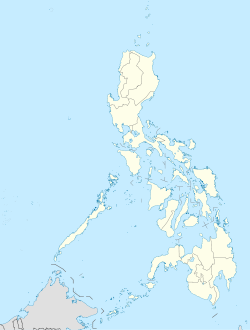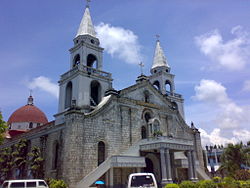- Jaro, Iloilo City
-
This article is about the city. For other uses, see Jaro, Iloilo City (disambiguation).
District of Jaro
Distrito sang Jaro
Jaro Distrito
Archdiocese of Jaro— District and Archdiocese — From top left, clockwise: Campanario de Jaro (Jaro Belfry), Lizares Mansion (Angelicum School Iloilo), Nelly Jardín (Nelly Garden), Monumento de Garciano López Jaena in Plaza Jaro (Jaro Cathedral/Jaro Metropolitan Cathedral)From top left, clockwise: Campanario de Jaro (Jaro Belfry), Lizares Mansion (Angelicum School Iloilo), Nelly Jardín (Nelly Garden), Monumento de Garciano López Jaena in Plaza Jaro (Jaro Cathedral/Jaro Metropolitan Cathedral)Nickname(s): "Seat of the Archbishopric of Jaro", " Location in the Philippines Coordinates: 10°41′24″N 122°33′0″E / 10.69°N 122.55°E Region  Philippines
PhilippinesProvince City Iloilo City Established (City) 1886 Incorporated (Iloilo City) July 16, 1937 Government – Mayor Jed Patrick Mabilog (Liberal) (Mayor of Iloilo City) Area – District and Archdiocese 27 km2 (10.4 sq mi) Elevation -2 to 6 m (-6.5 to 20 ft) Population – District and Archdiocese 343,829 – Metro 1,235,650 Demonym Jaroeño/Jareño, Taga-Jaro, Salognon Time zone PST (UTC+8) Area code(s) 5000 Patron Saint Nuestra Señora de la Candelaria (Our Lady of Candles) Feast Day February 2 Website [1] Archdiocese of Jaro
Archdiocesis JarensisLocation Country  Philippines
PhilippinesTerritory San Carlos, Kabankalan, San Jose de Buenavista Ecclesiastical province Iloilo Metropolitan Jaro, Iloilo City, Iloilo Statistics Population
- Total
1,761,419Information Denomination Roman Catholic Rite Roman Rite or Latin Rite Established May 27, 1865 (Diocese), June 29, 1951 (Archdiocese) Cathedral Jaro Metropolitan Cathedral, Jaro, Iloilo City Patron saint St. Elizabeth of Hungary Current leadership Pope Benedict XVI Archbishop Most Rev. Angel N. Lagdameo, D.D.
Archbishop of JaroWebsite [2] Jaro is one of the six districts of Iloilo City, in the Philippine province of Iloilo, on the island of Panay, in the Western Visayas.
It is the seat of the Catholic Archdiocese of Jaro, that covers the whole Western Visayan region. [1]
Contents
History
Its original name was Salog or Saro. It was also referred to as "Ilaya" or "mountain/dry land" together with La Paz which was referred to as "Ilawod" or "sea/wet land".[2] It had been one of the richer areas of Iloilo City even during the Spanish colonial period (1521-1898) and probably the richest town of the entire colony. Historical artifacts indicate that it had once conducted trade with China and Siam (Thailand) due to its port along the navigable river that ran through the town. It was also the center of religious and economic power in the Visayas during the Spanish rule.
Jaro officially became a city in 1886. La Paz was a part of Jaro until it became independent from Jaro and became a Town and incorporated into the City of Iloilo. It was later absorbed by the City of Iloilo along with the neighboring towns of Molo, Mandurriao, La Paz and Arevalo in the early 20th century when all economic activities were shifted to the port of Iloilo.
Located between Dungon Creek and the Jaro River, Jaro fulfills the ideal design for establishing communities during that era: a site between two rivers, with a church and plaza in the center, and homes of affluent families in the vicinity. The church is the famous Parish of Our Lady of Candles, also known as the Jaro Metropolitan Cathedral, the headquarters of the Archdiocese of Jaro and the site of a miraculous statue of the Virgin Mary, which was canonically crowned by the late Pope John Paul II during his visit in 1982. The image is the only religious icon in the country to have been personally crowned by a Pope.
Jaro's celebration of the Feast of Nuestra Señora de la Candelaria (Our Lady of the Candles) every February 2 is well-known in the Philippines. The fiesta features pageantry with a fiesta queen from one of the prominent families of the place, and a cockfight at the Iloilo Coliseum, where cockfighting aficionados from all over the Philippines converge.[3]
The district is notable for its large amount of nineteenth century architecture. Straddling the main plaza is the antique Jaro Catheral and the Palasyo, the Archbishop's residence.
Majority of the mestizo families from Iloilo came from this town, because it was a center and main port during Spanish period and many Spanish traders married natives and settled on the island.
Schools
- St. Vincent Ferrer Seminary (Founded 1865 - the oldest institution of higher education in Western Visayas)
- Colegio de San Jose (Founded 1872)
- University of San Agustin- High School Campus (Founded 1904)
- Central Philippine University (Founded 1905)
- De Paul College
- Angelicum School Iloilo (Founded 1978)
- Pius XII Institute
- AMA Computer College
- West Visayas State University
Also found in the district is the St. Joseph Regional Seminary, in Cubay. It is a theology seminary, as St. Vincent Seminary is a juniorate and philosophy seminary.
Main sights
- Jaro Belfry, ruined in a 1948 earthquake, but now restored. One of the few belfries in the country that stands apart from the church.
- Jaro Plaza, now called the Graciano Lopez Jaena Park, is the center of activity in Jaro and is surrounded by the Jaro Cathedral, the Jaro Belfry, several old mansions, the former Jaro City Hall and the Archbishop’s Palace.
- Jaro Cathedral, The Jaro Cathedral (Church of St. Elizabeth of Hungary) was built in 1864, the year the district was named a diocese by Pope Pius the IX, by order of His Grace Mariano Cuartero, first bishop of Jaro. Destroyed in the quake of January 1948 and restored by order of His Excellency Jose Ma. Cuenco, first archbishop of Jaro in 1956. The cathedral’s style is basically Baroque, with the addition of Gothic elements over many renovations.
- Archbishop's Palace, the residence of the Archbishop of Jaro. It is located southwest of the Jaro Cathedral and southeast of the Jaro Plaza.
- St. Vincent Ferrer Seminary
- Nelly Garden, the Lopez Mansion, also known as Nelly Garden, is one of the landmarks of Iloilo and a much-desired wedding venue due to its elegant facade and garden surroundings.
- Casa Montinola y Sanson, the house is reminiscent of the Gaston house in Silay City, Negros Occidental.
- Lizares Mansion, it was once the mansion of the Lizares family but was now turned into a school, Angelicum School Iloilo.
- Central Philippine University, the 24-hectare campus of CPU was chosen and declared as a tourism site by the Iloilo City Council. It was founded by the pioneer Protestant (Baptist) missionary, Rev. William Orison Valentine on 1905.
Notable residents
- Graciano Lopez Jaena - great revolutionary hero, editor, orator, journalist, writer of "La Solidaridad"
- Fernando López - former Vice-President of the Philippines and brother of Eugenio Lopez Sr.
- Eugenio Lopez Sr. - former Chairman of the Lopez Group of Companies
- Eugenio Lopez, Jr. - former Chairman Emeritus of ABS-CBN
- Eugenio Lopez III - present Chairman of ABS-CBN
- Raul M. Gonzalez - former Secretary of Justice of the Philippines
- Magdalena Jalandoni - Hiligaynon poetess
- Gil Lopez Kabayao - renowned violinist
- Miriam Defensor-Santiago - Senator
- Franklin Drilon - Senator
See also
External links
References
- ^ Also located in Jaro are the headquarters of the Convention of Philippine Baptist Churches (Protestant denomination), the 2nd Protestant University in the Country (the Central Philippine University), the first Baptist Church in the Islands (Jaro Evangelical Church, founded in 1901).
- ^ History of Panay, Felix B. Regalado, Quintin B. Franco, Central Philippine University, 1973
- ^ Salvilla, Rex S. (2003-01-30). "Iloilo Coliseum: World's biggest cockpit". Sun.Star Iloilo. http://www.sunstar.com.ph/static/ilo/2003/01/30/news/iloilo.coliseum.world.s.biggest.cockpit.html. Retrieved 2009-08-05.
Districts of Iloilo City Categories:- Districts of Iloilo City
Wikimedia Foundation. 2010.



